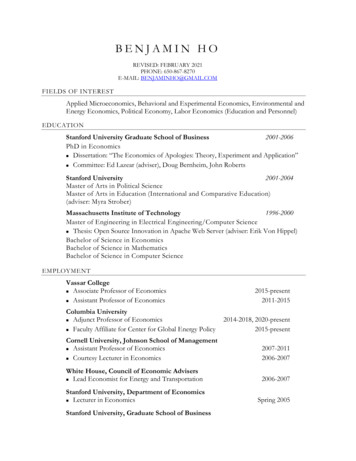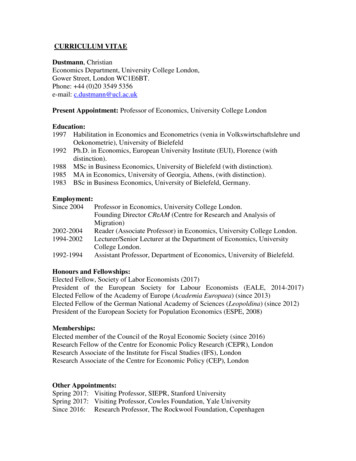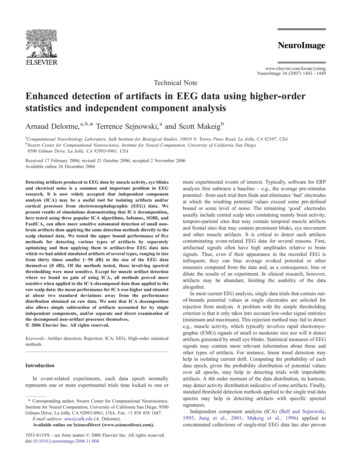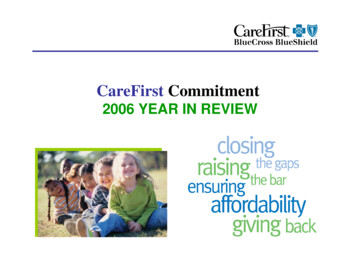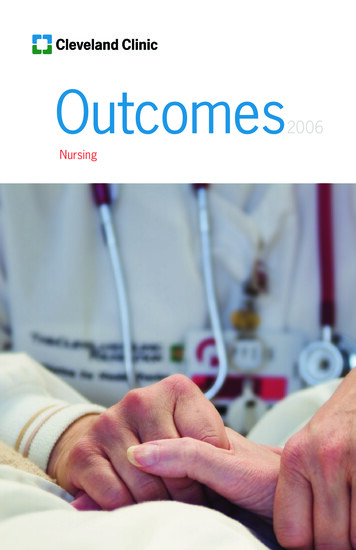
Transcription
Outcomes2006Nursing
Outcomes 2006Quality counts when referring patients to hospitalsand physicians, so Cleveland Clinic has created a seriesof outcomes books similar to this one for its institutesand departments. Designed for a health care provideraudience, the outcomes books contain a summary ofour surgical and medical trends and approaches; dataon patient volume and outcomes; and a review of newtechnologies and innovations. We hope you find thesedata valuable. To view all our outcomes books, visitCleveland Clinic’s Quality Web site atclevelandclinic.org/quality/outcomes.
Nursing 2006
Nursing Table of Contents Chair’s Letter5Division Overview6Quality & Outcome Measures14Quality Indicators14Advanced Practice Nursing18Ambulatory Nursing20Behavioral Health22Cancer Center26Center for Rehabilitation (Subacute)28Children’s Hospital Rehabilitation 30Critical Care 32Emergency Department and Clinical Decision Unit 34Heart Center 36Medicine40Surgical Floors42Surgical Services44World Class Service46Patient Experience48Innovations52New Knowledge60Leadership Team63Department Contacts Location65Cleveland Clinic Overview66Online Services67Cleveland Clinic Contact Numbers68
Nursing 2006
Nursing Chair’s Letter I am pleased to present our third edition of outcomes data from the Divisionof Nursing. This booklet includes a brief divisional overview of nursing, patientcare and administrative outcomes, and achievements in 2006 that sustain andenhance quality patient care, patient safety and a satisfying patient experience.While we have much to be proud of, we recognize the need for continual growthand development. Data collected during the year provides us with informationneeded to objectively assess our strengths and opportunities for growth. Thisdata helps us develop strategic and operational plans that will further enhancequality of patient care, help us meet and anticipate patient and family needs,and improve nurses’ ability to care for patients and themselves.Nursing involves multidisciplinary collegiality with healthcare colleagues andinnovative ideas that ultimately enhance nursing processes and systems ofcare. Our environment supports both, leading to excellence in nursing care andprofessional nurse growth.We hope by sharing this information with our healthcare community, we helpnurses, healthcare professionals and others learn about accomplishments inthe Division of Nursing and expand the science of nursing. We believe we areyour destination for nursing practice and that our successes can inspire otherstoward future success.Claire M. Young, RN, MSN, MBAChief Nursing Officer and Chair, Division of Nursing
Nursing 2006Division Overview The Division of Nursing at Cleveland Clinic is comprised of registered nurses,licensed practical nurses, nurse associates, patient care nursing assistants,clinical, surgical and equipment technicians, patient service associates, clinicalinstructors, clinical nurse specialists, advanced practice nurses and health unitcoordinators who provide best-in-class care to our patient populations. Nurses andsupport staff practice on more than 40 specialty-based nursing units, including 14intensive care units, an emergency department and clinical decision unit, a hospitaltransfer unit, a 59-bed subacute care unit, and 59 operating rooms. More than300 advanced practice nurses, including certified nurse practitioners, certifiedregistered nurse anesthetists, clinical nurse specialists and certified nurse midwivescollaborate with physicians to manage patient care in the inpatient, outpatient andperioperative settings.The Division sponsors multiple educational programs on the main campus,including a patient care nursing assistant training program, a Surgical Techniciantraining program in collaboration with Cuyahoga Community College, and programsto prepare nurse anesthetists, enterostomal therapy and wound care nurses for thespecialized roles they fulfill in patient care.In partnership with Cuyahoga Community College and under the auspices of aU.S. Department of Labor grant, a new educational endeavor was initiated totrain and develop current employees interested in becoming registered nurses.The inaugural class comprises 64 students (32 from main campus, 32 fromregional hospitals) who will graduate with an associate degree in nursing after fourconsecutive semesters.
Nursing Awards and AccoladesThe hospitals, outpatient clinics, home care programs, ambulatory surgerycenters and family health centers of Cleveland Clinic are accredited by the JointCommission on Accreditation of Healthcare Organizations (JCAHO).The Division of Nursing staff achieved Magnet status in 2003, the recognitionof excellence in nursing by the American Nurses Credentialing Center (ANCC).Cleveland Clinic was the third hospital in Ohio to achieve this recognition and the72nd in the United States.Our Web site received a Silver Award in the Best Staff Recruitment category fromthe 2006 eHealthcare Leadership Awards competition.According to the 2006 U.S. News & World Report “America’s Best Hospitals”survey, Cleveland Clinic is one of the top three hospitals in the United States. OurHeart and Vascular Institute has been ranked first in the nation for the past 12years and 11 of its specialties rank among the nation’s top 10.Cleveland Clinic and its community hospitals were recognized as 2006 NorthCoast99 award winners as being great workplaces for top performers in the NortheastOhio area.Nursing Education and ResearchChanges in the nursing workforce (less experienced nurses, more new graduatenurses, the necessity to develop critical thinking in new RNs, the need for preceptorsupport and mentoring and the complex care needs of patients) challenged themembers of the Department of Nursing Education and Professional PracticeDevelopment to examine current orientation processes and content as well asongoing staff development courses.
Nursing 2006The ability to offer didactic content via an online format provided the educatorsthe opportunity to redesign all course content, delivery of this content andlearning evaluations. A multimedia instructional designer was hired to work withthe educators to create interactive and instructional online courses. A state-ofthe-art nursing lab with six medical-surgical beds and two critical care beds anda 40-computer classroom were added to the arsenal of resources for employeedevelopment. All new employees, both experienced and new graduates, areassessed regarding content and skill expertise upon hire and an individualorientation program is designed for each. Continuing education courses andannual required competencies are now available online, thus increasing the accessand flexibility for nurses to obtain continuing education and complete requiredcompetencies.Known the world over for its strong basic science foundation and its fundamentalmission as a clinical research hospital, Cleveland Clinic continues to placeemphasis on patient-centered and administrative nursing research and innovations.All nurses are encouraged to engage in scientific inquiry and can receive help asneeded by doctorate- and master-prepared nurses with research experience.Additionally, nursing resources are available to decrease a researcher’s burden,including statistician support, Web-based data collection system and intranet fileswith templates and guidelines.In 2006, more than 30 nursing research projects were reviewed by our InstitutionalReview Board and initiated. Other projects were presented at national meetingsand are in peer-review for publication. Engaging and facilitating nursing researchpromotes sharing of new knowledge, strengthens the foundation of nursingpractice, and promotes nursing care that is evidence-based -- all important factorsin improving patient outcomes.
Nursing Patient Volumes1-ICU Patient Days ICU& AdmissionsPatient Days & Admissions50,0007,200DaysAdmitsDays 42,00034,0006,400 Admits200220032004200520065,600ICU patient days and admissions stabilized in 2006; however, with the addition ofeight neurology ICU beds in January 2007, this growth trend will likely resume.2-Non-ICU PatientDays & AdmissionsNon-ICU Patient Days & Admissions260,00044,000DaysAdmitsDays 230,000200,00041,000 Admits2002200320042005200638,000Admissions rose significantly this past year while patient days rose only slightly.These results reflect the focused efforts on improving patient throughput.
10 Nursing 2006Nurse Staff Resources: Implementing the ideal staffing model to accomplish superiorpatient outcomes is a challenge because experience, nursing education level, nurseto-patient ratio, availability of staff, and patient characteristics and needs must beconsidered. Due to the complexity and specialization of Cleveland Clinic, each unitmatches patient needs to the appropriate care team skill mix.Nursing Staff Skill Mix1008060%40200RN - ICUNon-RNICURN-FloorsNon-RNFloorsRN-ORNon-RN ORWe are gradually adjusting the skill mix to optimize patient outcome, safetyand staff satisfaction.Nursing Staff by Title602005 FTEs2006 FTEs40%200RNLPNANM NM/AdminUnitCoordNon CGUAP
Nursing 11Breakdown of New Hires80Experienced NurseNew Grad60% 402002003200420052006The trend of hiring more new graduate nurses is due in part to the multitude ofprograms created to attract new graduates: Summer Student Experience Nurse Associate Program Extended Orientation Nursing Education Assistance Program Increased On-Site Clinical Rotations for Nursing StudentsNumber of Staffed 6Due to increasing access demands, the Division of Nursing has opened additionalpatient beds each year. In 2006 a 12-bed Hospital Transfer Unit was opened tofacilitate transfers from referring hospitals.
12 Nursing 2006Commitment to Quality and Patient SafetyQuality patient outcomes are a benchmark for the healthcare environment today. Resultsof publicly reported indicators from the Joint Commission, organizations focusing onquality and national databases raised awareness and a focus of delivering care to achieveoptimal outcomes. Because nurse staffing and models of care delivery impact outcomesas well, key indicators related to staffing effectiveness and the patient experience havebeen monitored throughout the implementation of the care team model.The Department of Nursing Quality leads the Division of Nursing’s efforts in theimprovement of nursing practice and patient care and the collection, analysis andutilization of data from nurse quality indicators. In addition, Nursing Quality coordinatesthe Division’s efforts toward strong unit-level performance improvement through support,education and oversight. Unit-based quality representatives are charged with leadingthe initiatives for improvement on their units in conjunction with unit leadership. Theseefforts resulted in consistent monitoring and improvement of pain assessment, bloodadministration and patient education scores across the division.Prevention and treatment of hospital-acquired pressure ulcers has been a focus ofactivity for the Department of Nursing Quality. Working with the Department of NursingInformatics, a bedside electronic documentation system was developed to create a skincare database and document patient treatment notes simultaneously, decreasing dataentry time and the need for multiple-site documentation. This database provides a robustrepository for analysis and improvement of skin care efforts.Another focus was falls prevention. The Hendrich II Falls Assessment was selected andimplemented in an effort to demonstrate a renewed commitment to falls prevention.Since the implementation of this evidence-based tool in early 2006, a modest decrease inhospital falls rate has occurred.The Department of Nursing Quality collaborates with a variety of departments within theDivision and across the organization including the Nursing Accreditation Coordinator forMagnet redesignation, Nursing World Class Service, the Councils for Nursing Practice,Education and Research and Cleveland Clinic’s World Class Service on efforts to improvepatient and staff satisfaction. The department also collaborates with the Quality and PatientSafety Institute to coordinate the Division’s role in the interdisciplinary efforts related to theimprovement of patient outcomes and the patient experience across the organization.
Nursing 13
14 Nursing 2006Quality & Outcome Measures Quality IndicatorsFallsFalls rates for hospitalized patients remain a key initiative for Nursing Quality. In2006 we introduced an evidenced-based falls assessment tool, standardized thecommunication of high risk, and provided education to all members of the healthcare team on their role in falls prevention. We continue to identify and target keyinterventions for key populations of patients. For example, when diuretics aregiven to older cardiac patients, we provide an extra reminder to patients to usethe nurse call system for elimination needs.National Benchmark equals the mean over a two-year period for hospitalsgreater than 500 beds, per the National Database of Nursing Quality Indicators.Data results on unit type designation definitions are limited due to the occurrenceof mixed patient types (i.e. medical or surgical) on most units.Intensive Care Units (11 Units)1.00.75Falls/1,000 Cleveland Clinic, falls rates below national benchmark mean.
Nursing 15Step Down Units (8 Units)43Falls/1,000 nd Clinic, falls rates below national benchmark mean.Medical Care Units (8 Units)86Falls/1,000 nd Clinic, falls rates below national benchmark mean.Med-Surg Units (2-3 Units)86Falls/1,000 PatientDays4202001*20022003*200420052006*Cleveland Clinic, falls rates below national benchmark mean.
16 Nursing 2006Surgical Care Units (6 Units)43Falls/1,000 PatientDays210200120022003200420052006*Cleveland Clinic, falls rates below national benchmark mean.Pressure UlcersPrevention of pressure ulcers for hospitalized patients is also an important nursingquality indicator. In 2006, an electronic documentation system was developed for skincare nurses to assist with staff education and patient consultation. A heel protectivedevice and skin care product standardization was also introduced on the nursing units.We continue to identify and focus education for clinical areas with high risk patients.Hospital-Acquired Pressure Ulcers12Hill RomCleve ClinicTeaching Hospital9%Prevalence6302003200420052006
Nursing 17Hospital-Acquired Pressure Ulcers2015%10Prevalence50AdultCritical CareAdultStep Down*Adult MedAdult SurgAdult MedSurg**Cleveland Clinic prevalence rate is below national benchmark mean.At Risk for Hospital-Acquired Ulcers1008060%40200Adult ICUAdultAdult MedStep Down*Adult SurgAdult MedSurg**Cleveland Clinic prevalence rate is below national benchmark mean.
18 Nursing 2006Quality & Outcome Measures Advanced Practice NursingOverall Quality of Advanced Practice Nurse CareAdvanced practice nurses (APN) includes certified nurse practitioners (CRNP),clinical nurse specialists (CNS), certified nurse midwives (CNM), and certifiedregistered nurse anesthetists (CRNA). APNs work in a variety of settings fromprimary to specialty care, as well as in critical care hospital environments. APNsprovide a variety of services to patients and families based on their specificroles and training. In our ambulatory service areas on the main campus and inRegional Medical Practice, the quality of APN care has been assessed each ofthe last two years.Rating of Overall Quality of Care1002005200680%6040200ExcellentVery GoodGoodFairPoor
Nursing 19Patient Satisfaction with Advanced Practice NursesWhen APNs were rated for quality of care as a provider, they excelledin each of the past two years. Additionally, when APNs were rated forthoroughness in care provided, a majority of patients rated them very goodto excellent.Advanced Practice Nurse100200520068060%40200ExcellentVery GoodGoodFairPoorProvider Thoroughness with Care100200520068060%40200ExcellentVery GoodGoodFairPoor
20 Nursing 2006Ambulatory NursingPatient Perception of Ambulatory ClinicsMajority of patients rated nursing staff and medical assistants as excellent andvery good at being sensitive to their needs.10080%Staff Sensitivity to Needs200420052006N 37,5946040200ExcellentVery GoodGoodFairPoorBariatric EducationNursing staff sensitivity to needs is imperative when conducting patient education.In rating the nurses’ ability to offer a clear and knowledgeable presentation, 75%of the respondents receiving bariatric education rated nurses as excellent.Nurses Ability to Offer Clear and Knowledgeable Presentation100Q1Q2Q3Q480%6040N 481200ExcellentVery GoodGoodFairPoor
Nursing 21Diabetic EducationIn healthy, non diabetic patients, HbA1c levels are less than 7% of totalhemoglobin. Complications of diabetes can be delayed or prevented if HbA1clevels are below or close to 7%. There was a significant reduction in HbA1cafter diabetes education classes.10(N 129)8MeanHbA1c6420Pre-educationPost-education
22 Nursing 2006Behavioral HealthChild and Adolescent PsychiatryAssault without InjuryGoal: provide an emotionally and physically safe environment. Dangerous behavior canlead to assault and an episode of seclusion or restraint. At Cleveland Clinic, less than 5%of patients need seclusion or restraints.Our success was facilitated by heightened focus by the interdisciplinary treatment team on prevention and safephysical crisis intervention the patient experiencing seclusion/restraint in-service on “trauma informed care” interdisciplinary team meetings to review patients with multiple episodes of seclusion review of episodes of assault or seclusion/restraint by nursing leadershipQuarters, 2006Assaults, NAssaults with Injury, N1st502nd403rd1024th51
Nursing 23Child/Adolescent Restraint and SeclusionEpisodes of Restraint and Seclusion10010Seclusion RateRestraint Q4Q1Q20042Q3Q4Q1Q20052Q3Q4Q2006Restraint and Seclusion Rate150Beyond Limits125100*UCL 89.72Ratio 7550Mean 43.5425 LCL 0.000Jan Feb Mar Apr May Jun Jul Aug Sep Oct Nov Dec Jan Feb Mar Apr May Jun Jul Aug Sep Oct Nov Dec2005*UCL Upper Control Limit LCL Lower Control Limit20060
24 Nursing 2006Alcohol and Drug Recovery CenterAddictive disorders affect those suffering with the addiction and their family members.In 2006, the Alcohol and Drug Recovery Center nursing and counseling staff providedconsistent facilitators in family groups. Of the 113 family members that completedfamily satisfaction surveys, most rated their overall experience with the group asexcellent and very good.Family Satisfaction with Support & Education100Q1Q2Q3Q480%60N 11340200ExcellentVery GoodGoodFair
Nursing 25
26 Nursing 2006Cancer CenterInpatient Rates for Falls with InjuryDuring 2006, the inpatient cancer units achieved a 52% reduction in falls withoutany injury and a 100% reduction in falls resulting in serious injury. Key interventionsincluded the introduction of the Stryker bed on Palliative Medicine (bed hasenhanced personal alarm system).40Falls without injuryFalls with serious injury30#201002005200620062005Participation in Oncology CoursesThe Oncology Nursing Society recommends registered nurses responsible foradministering chemotherapy should attend an educational course. In 2006, 100%of nurses administering chemotherapy completed the Oncology Nursing Societycourse in addition to the required core education provided by Cleveland Clinic.10080%604020020052006
Nursing 27Discharges by NoonInpatient bed capacity to enhance throughput is important. During 2006, theinitiative to discharge patients by noon continued. Interventions in 2006 includedthe creation of a hematology oncology admissions unit. This unit allows patients tobe admitted earlier in the day and begin therapy. This, in turn, allows patients to bedischarged earlier in the day. Additionally, an oncology care coordinator positionwas created to provide care to patients in the admissions unit and support patientswho are off service by initiating chemotherapy and delivering education.Patients Discharged by Noon4030%20Frequency100200420052006Pain AssessmentPain assessment is an essential component of care. The inpatient cancer centerunits achieved a 16% improvement in the percentage of patients who had painassessed as their fifth vital sign in 2006. This exceeds the target of 90%.Key interventions included clarification of staff expectations and educationof frontline staff.Pain Assessed with Vital Signs10080%604020020052006
28 Nursing 2006Center for Rehabilitation (Subacute)Patient SatisfactionService rounds are routinely conducted by the Administrator, Medical Director, NurseManager, and Assistant Nurse Manager. Additionally, to ensure patient needs arebeing met, a Patient Service Associate role was added in 2006. When Center forRehabilitation patients were asked, “Would you recommend care from this unit?”responses improved in 2006.Response to “Would you Recommend Hospital to Family and Friends”8060%4020020042005Jan - June2006Overall Quality of CareTo enhance patient perception of overall quality, the Nurse Manager and AssistantNurse Manager team conduct routine leadership rounds with staff and qualityaudits of patient care. Frontline staff were also engaged in education and workedas a team to create an enhanced environment for patient care.Overall Quality of Care806040%Excellent200200420052006
Nursing 29Hospital-Acquired UlcersLicensed nursing staff complete a head-to-toe skin assessment on patients admittedto the Center for Rehabilitation. This assessment indicates the need for preventiveskin interventions or active treatment of a pressure area. Daily Braden scores areconducted to assess the patient’s risk for skin breakdown and initiate preventivetreatments. Weekly reporting allows the health care team to monitor the progress ofthe pressure area and adjust the care plan accordingly.4National Benchmark 3.3/1,000 Patient Days3AcquiredUlcers/1,000 2Patient Days1020052006Patient FallsLicensed nursing staff conduct a falls risk assessment on admission to the unit andevery shift during the patient’s stay. Hourly rounding was the primary intervention todecrease the number of patient falls in 2006.4National Target2.7/1,000 Patient Days3Falls/1,0002Patient Days1020052006
30 Nursing 2006Children’s HosptialInpatient Falls RateThe Children’s Hospital for Rehabilitation conducts a falls risk assessment on eachpatient every day and implements falls precautions when children are at risk. Datacompiled are discussed, shared, and disseminated with team leaders every month.Of the nine falls in 2006, there were no injuries to patients from any of the falls.0.5200520060.4FallsRate/100Patient Days0.30.20.10.0Jan Feb Mar Apr May JunJulAug Sep OctNov Dec
Nursing 31Influenza VaccineChildren who currently receive chemotherapy, those who have been offchemotherapy less than six months and those with sickle cell disease receivean influenza vaccine.The pediatric hematology/oncology outpatient area has a system to ensureinfluenza vaccine is administered. Children who do not receive the vaccine maybe ill at the time of the visit or may have received the vaccine from a primarycare physician. Parents may refuse the administration of the vaccine.Receiving Influenza 2006
32 Nursing 2006Critical CareMedical Intensive Care UnitVentilator-Acquired PneumoniaIn the second half of 2005, evidence-based practices to reduce the incidence ofventilator acquired pneumonia were implemented in the Medical Intensive Care Unit(MICU), including a 30º elevation of the head-of-the-bed and frequent oral care withsubglottic suctioning.Since then, there has been a steady decrease in the rate of ventilator acquiredpneumonia, even though the number of days patients spend on a ventilator increased.Ventilator Acquired Pneumonia (VAP)0.8VAPThreshold0.6%Occurrences/100 0.4Ventilator Days0.20200420052006
Nursing 33Surgical Intensive Care UnitPressure UlcersThe Surgical Intensive Care Unit (SICU) had a decrease in the number of unit-acquiredpressure ulcers that develop into stage 3, 4 and non-stageable ulcers. Initiatives thatassisted in accomplishing this goal are: addition of three new unit-based Skin CareNurses, weekly rounds by a Skin Care Nurse and clinical technician to assess patients’pressure points and address treatment plan concerns, an upgrade in bed surface tonewer beds that control pressure-better monthly in-services on skin care products,posting skin care issues on an inservice board each month and discussing qualityreports at monthly staff meetings.Stage 3 or 4 Acquired Skin Impairment4030# 2010020052006
34 Nursing 2006Emergency Department and Clinical Decision UnitNurse and Patient-Visitor Communication in the Emergency Department:Meeting NeedsA survey was conducted to learn what nurse communication factors are importantto patients and visitors and how well we met their communication needs. Nursesmet patient and visitor communication expectations at a very good or excellentlevel in nine (47%) of the 19 communication factors studied. This informationprovides direction for changes that can better meet patient and visitor needs andexpectations.The top five communication factors in response to “how well we did in meetingcommunication needs” by patients and visitors as very good or excellent aredisplayed below.Nurse Communication with Patients and VisitorsUses a Calm VoiceMeets Language NeedsShows RespectN 115Uses Simple TermsAllows to Talkwithout Interruptions020406080100Very Good to Excellent (%)Falls Risk Assessment Documentation in the Clinical Decision UnitIn May 2006, the Clinical Decision Unit (CDU) nursing team implemented the HendrichII Falls Risk Assessment tool (a validated tool) to replace a generic assessment offalls risk. Patients identified as a high falls risk upon admission and with conditionchanges are moved closer to the nurses’ station. A falling leaf sticker and magnetidentify patients at high falls risk to the team.Prior to 2006, CDU falls risk assessment was consistently above 94%. After initiatingthe Hendrich II tool, assessment adherence increased and falls were low, eventhough many of our patients were elderly.
Nursing 35Falls Assessment Completion1008060CompletionRate3 Falls1 FallFalls AssessmentJan-JuneHendrich ToolJuly-Dec40200Door to Electrocardiogram Time in Acute ST Elevation Myocardial InfarctionThe national standard for Door to Electrocardiogram (ECG) time in acute ST elevationmyocardial infarction is 10 minutes.A multidisciplinary subcommittee of the emergency medicine performanceimprovement team was formed to improve performance and consisted of anemergency medicine physician, nurses, clinical technicians and a manager from theOffice of Quality.Triage practice was revised in June 2006, including obtaining an ECG prior to nurseassessment, intravenous start and serum laboratory draws. In the triage area, clinicaltechnicians were empowered to obtain an ECG in patients with a complaint of chestpain, and then the ECG is taken to the ED staff physician for a formal reading.Door to Electrocardiogram20MeanMedian15Minutes 105020052nd Half1st Half2006
36 Nursing 2006Heart CenterCardiac Rehabilitation Referrals Post-Percutaneous Coronary Intervention(PCI)In late 2005, Heart Center Nursing began an initiative to improve referrals to cardiacrehabilitation in conjunction with Preventive Cardiology. By November of 2005,structures and processes were implemented that included cardiac step-down nursingstaff and health unit coordinator training, delivery of outpatient cardiac rehabilitationeducational pamphlets to patients, and modification of pre-printed post percutaneouscoronary intervention order set to include automatic consults for Phases 1 and 2cardiac rehabilitation. Improving activity levels in-hospital and early post-hospitaldischarge prevents muscle deconditioning and improves patient quality of life.Referrals Post PCI802005200660# 40200Jan Feb Mar Apr May JunJulAug Sep Oct Nov Dec
Nursing 37Congestive Heart Failure Discharge EducationHeart Center Nursing improved scores for delivering patient education in congestiveheart failure (CHF) prior to hospital discharge in 2005 and continues to consistentlymeet the standard above 75% throughout 2006.CHF Education8060% 402001Q2Q3Q20054Q1Q2Q3Q20064Q
38 Nursing 2006Decreasing Length of StayIn March 2006, Heart Center Nursing joined with the Departments of CardiothoracicSurgery and Cardiovascular Medicine to develop strategies to decrease hospitallength of stay after cardiothoracic surgery. Nursing coordinated and participatedin “Daily Huddles.” Daily Huddles involve multidisciplinary team members (nursingmanagement, charge nurse, acute care nurse practitioner, discharge coordinator,cardiologist, case manager and respiratory therapist) on intermediate care unitsand focus on discharge needs of patients. Daily Huddles led to a decrease in lengthof stay in two of three intermediate care areas.Length of Stay11.0Nursing Unit 1Nursing Unit 2Nursing Unit 310.810.6Days10.410.210.09.89.620052006
Nursing 39Predictors of Call Light UseUsing research methodology, we surveyed 164 patients (54% cardiac surgeryfloors and 46% medical cardiac floors) to learn predictors of call light use. Of32 indicators the top five responses of “very likely” referred to needs for painreduction and addressing unusual alarms. Our next step is to design interventionsto reduce call light use for routine pain and alarm interruptions.Call Light SurveyChest P
including a patient care nursing assistant training program, a Surgical Technician training program in collaboration with Cuyahoga Community College, and programs . In partnership with Cuyahoga Community College and under the auspices of a U.S. Department of Labor grant, a new educational endeavor was initiated to .


